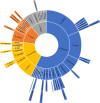Characterization of Polybacterial versus Monobacterial Conjunctivitis Infections in Pediatric Subjects Across Multiple Studies and Microbiological Outcomes with Besifloxacin Ophthalmic Suspension 0.6
- PMID: 34785887
- PMCID: PMC8591116
- DOI: 10.2147/OPTH.S335197
Characterization of Polybacterial versus Monobacterial Conjunctivitis Infections in Pediatric Subjects Across Multiple Studies and Microbiological Outcomes with Besifloxacin Ophthalmic Suspension 0.6
Abstract
Introduction: The choice of empiric therapy for bacterial conjunctivitis should be guided by an awareness of typical causative pathogen distributions. Bacterial conjunctivitis can be polybacterial, although pediatric-specific data are lacking.
Methods: This was a post-hoc analysis of data in pediatric subjects (1-17 years) from five bacterial conjunctivitis trials evaluating besifloxacin ophthalmic solution 0.6%.
Results: Of the 730 pediatric subjects with culture-confirmed conjunctivitis, nearly one-fourth (23.6%) had polybacterial infections and three-fourths (76.4%) had monobacterial infections at baseline. In both polybacterial and monobacterial infections, the most prevalent organisms were Haemophilus influenzae, Streptococcus pneumoniae, Staphylococcus aureus, and Streptococcus mitis/S. mitis group. In polybacterial versus monobacterial infections, S. mitis/S. mitis group (8.7% vs 4.3%; P=0.032) and Moraxella catarrhalis (4.7% vs 0.5%; P<0.001) were identified more frequently, whereas S. pneumoniae (14.0% vs 28.1%; P<0.001) was identified less frequently, as the dominant infecting species. MICs for individual species were similar for tested antibiotics regardless of polybacterial or monobacterial infection, except Staphylococcus epidermidis for which fluoroquinolone MICs were ≥3 dilutions higher for isolates of this species sourced from polybacterial compared to monobacterial infections. Treatment with besifloxacin resulted in microbial eradication in 79.1% of polybacterial and 92.3% of monobacterial infections (P≤0.005 vs vehicle).
Discussion: One in four pediatric bacterial conjunctivitis infections is polybacterial, highlighting the need for a broad-spectrum antibiotic when choosing empiric therapy.
Keywords: besifloxacin; conjunctivitis; minimum inhibitory concentration; pediatric; polybacterial.
© 2021 Blondeau et al.
Conflict of interest statement
HH DeCory & CM Sanfilippo are employees of Bausch Health US, LLC. Statistical analysis was conducted by HM Proskin, funded by Bausch Health US, LLC. JM Blondeau has received independent research grants from Bausch Health US, LLC. The authors report no other conflicts of interest in this work.
Figures


Similar articles
-
Characterization of baseline polybacterial versus monobacterial infections in three randomized controlled bacterial conjunctivitis trials and microbial outcomes with besifloxacin ophthalmic suspension 0.6.PLoS One. 2020 Aug 25;15(8):e0237603. doi: 10.1371/journal.pone.0237603. eCollection 2020. PLoS One. 2020. PMID: 32841261 Free PMC article. Clinical Trial.
-
Efficacy and safety of besifloxacin ophthalmic suspension 0.6% compared with moxifloxacin ophthalmic solution 0.5% for treating bacterial conjunctivitis.Ophthalmology. 2009 Sep;116(9):1615-1623.e1. doi: 10.1016/j.ophtha.2009.05.014. Epub 2009 Jul 29. Ophthalmology. 2009. PMID: 19643483 Clinical Trial.
-
Besifloxacin: a topical fluoroquinolone for the treatment of bacterial conjunctivitis.Clin Ther. 2010 Mar;32(3):454-71. doi: 10.1016/j.clinthera.2010.03.013. Clin Ther. 2010. PMID: 20399984 Review.
-
Integrated analysis of three bacterial conjunctivitis trials of besifloxacin ophthalmic suspension, 0.6%: etiology of bacterial conjunctivitis and antibacterial susceptibility profile.Clin Ophthalmol. 2011;5:1369-79. doi: 10.2147/OPTH.S23519. Epub 2011 Sep 21. Clin Ophthalmol. 2011. PMID: 22034556 Free PMC article.
-
Besifloxacin ophthalmic suspension, 0.6%: a novel topical fluoroquinolone for bacterial conjunctivitis.Adv Ther. 2012 Jun;29(6):473-90. doi: 10.1007/s12325-012-0027-7. Epub 2012 Jun 20. Adv Ther. 2012. PMID: 22729919 Review.
References
LinkOut - more resources
Full Text Sources

